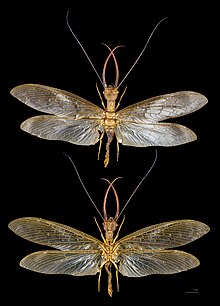
Back كبيرات الأجنحة Arabic كبيرات الاجنحه ARZ Megaloptera AST İriqanadlılar Azerbaijani Віслакрылыя Byelorussian Megalòpters Catalan Megaloptera CEB Střechatky Czech Dovenfluer Danish Großflügler German
| Megaloptera Temporal range:
| |
|---|---|

| |
| Alderfly of the genus Sialis | |
| Scientific classification | |
| Domain: | Eukaryota |
| Kingdom: | Animalia |
| Phylum: | Arthropoda |
| Class: | Insecta |
| Clade: | Neuropterida |
| Order: | Megaloptera Latreille, 1802 |
| Families | |
| |

Megaloptera is an order of insects. It contains the alderflies, dobsonflies and fishflies, and there are about 300 known species.
The order's name comes from Ancient Greek, from mega- (μέγα-) "large" + pteryx (πτέρυξ) "wing", in reference to the large, clumsy wings of these insects. Megaloptera are relatively unknown insects across much of their range, due to the adults' short lives, the aquatic larvae's often-high tolerance of pollution (so they are not often encountered by swimmers etc.), and the generally crepuscular or nocturnal habits. However, in the Americas the dobsonflies are rather well known, as their males have tusk-like mandibles. These, while formidable in appearance, are relatively harmless to humans and other animals; much like a peacock's feathers, they serve mainly to impress females. However, the mandibles are also used to hold females during mating, and some male dobsonflies spar with each other in courtship displays, trying to flip each other over with their long mandibles.[1] Dobsonfly larvae, commonly called hellgrammites, are often used for angling bait in North America.
The Megaloptera were formerly considered part of a group then called Neuroptera, together with lacewings and snakeflies, but these are now generally considered to be separate orders, with Neuroptera referring to the lacewings and relatives (which were formerly called Planipennia). The former Neuroptera, particularly the lacewing group, are nonetheless very closely related to each other, and the new name for this group is Neuropterida.[2] This is either placed at superorder rank, with the Holometabola—of which they are part—becoming an unranked clade above it, or the Holometabola are maintained as a superorder, with an unranked Neuropterida being a part of them. Within the holometabolans, the closest living relatives of the neuropteridan clade are the beetles.
The Asian dobsonfly Acanthacorydalis fruhstorferi can have a wingspan of up to 21.6 cm (8.5 in), making it the largest aquatic insect in the world by this measurement.[3]
- ^ Álvarez, Hugo Alejandro; Tierno de Figueroa, José Manuel; Cebada-Ruiz, Jorge Alejandro (3 April 2019). "The expression of aggression in the dobsonflies Corydalus magnus Contreras-Ramos, 1998 and Platyneuromus soror (Hagen, 1861) (Megaloptera: Corydalidae)". Aquatic Insects. 40 (2): 137–145. doi:10.1080/01650424.2018.1564332.
- ^ Also called "Neuropteroidea", though the ending "-oidea" is normally used for superfamilies. [citation needed].
- ^ "Largest aquatic insect (by wingspan)". Guinness World Records. Retrieved 4 April 2018.
© MMXXIII Rich X Search. We shall prevail. All rights reserved. Rich X Search